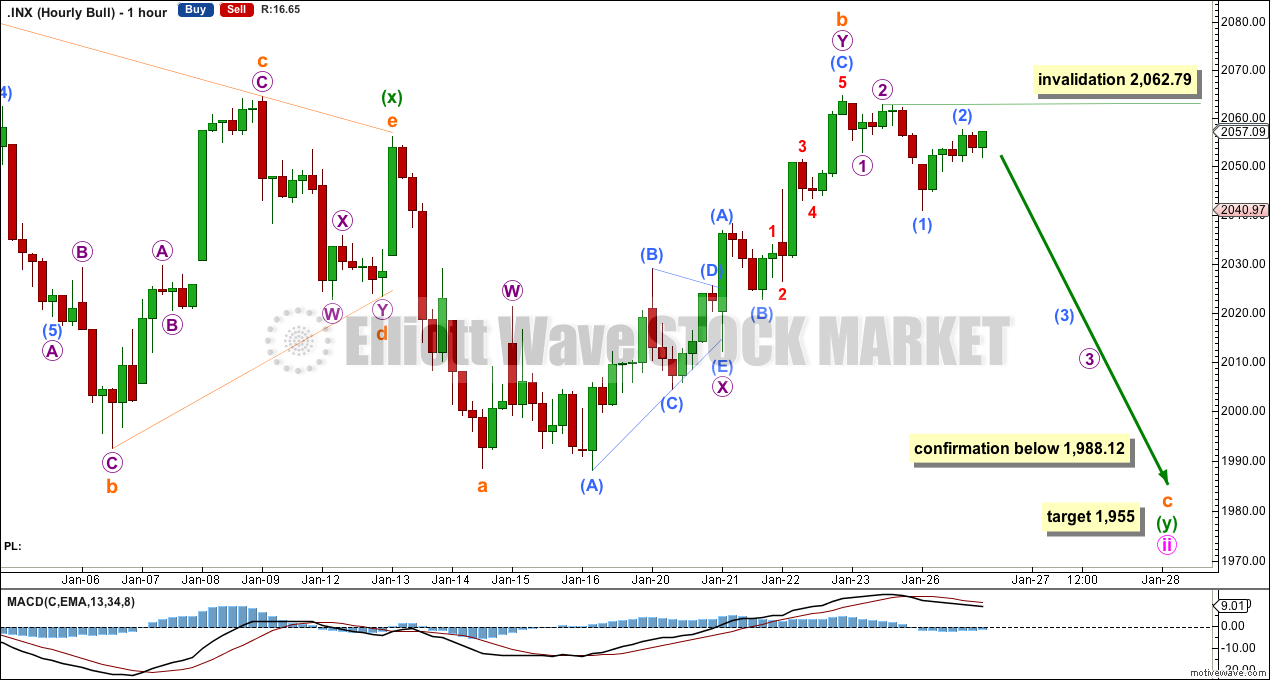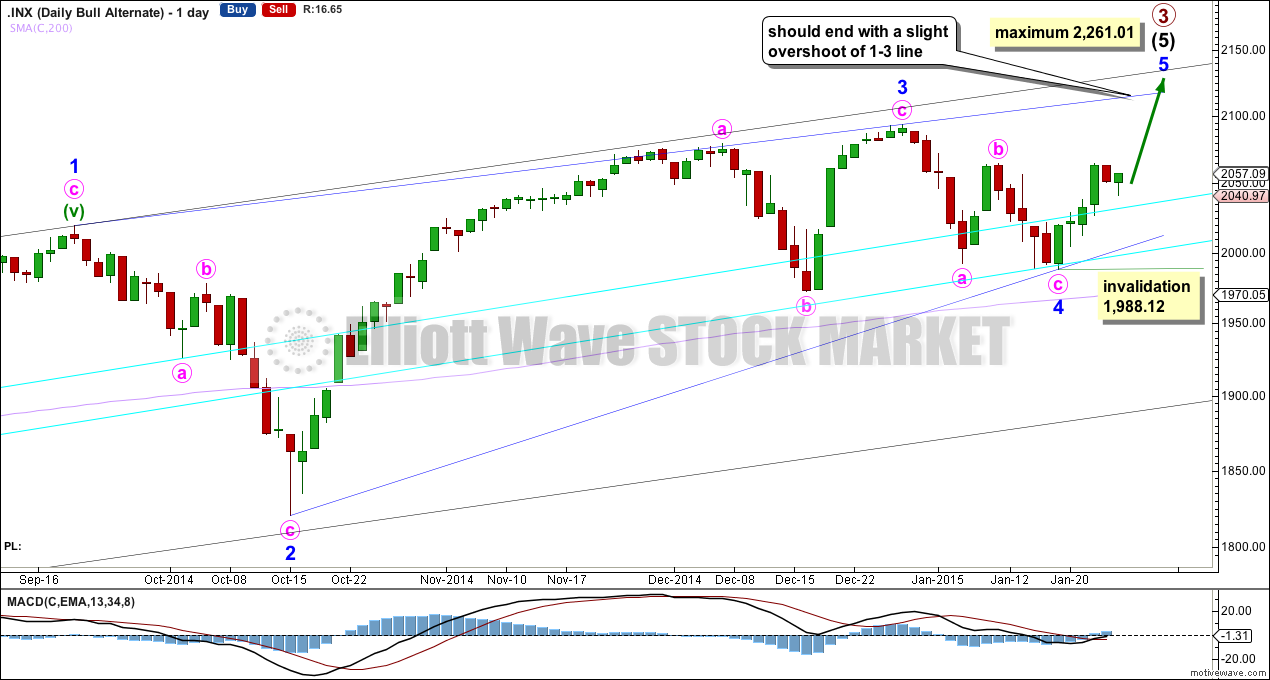Downwards movement was expected for Monday. The session did begin with downwards movement, but that was retraced to complete a green candlestick.
Summary: The main wave count requires downwards movement from here. A new low below 1,988.12 would confirm the main count and invalidate the alternate. A new high above 2,062.79 would invalidate the main count and confirm the alternate, and at that stage the target for upwards movement would be 2,117.
Click on charts to enlarge.
Main Bull Wave Count
I will favor neither the bull or bear wave count. Both are viable and both expect this current upwards impulse may again be close to complete.
To see a weekly chart with subdivisions and how to draw trend lines and channels click here.
Upwards movement from the low at 666.79 subdivides as an incomplete 5-3-5. For the bull wave count this is seen as primary waves 1-2-3.
The aqua blue trend lines are traditional technical analysis trend lines. These lines are long held, repeatedly tested, and shallow enough to be highly technically significant. When the lower of these double trend lines is breached by a close of 3% or more of market value that should indicate a trend change. It does not indicate what degree the trend change should be though. It looks like the last two corrections may have ended about the lower aqua blue trend line, which gives the wave count a typical look.
I have pulled the upper trend line down a little to touch the low of minute wave a within minor wave 4. This may be a better position for recent movement.
There is still triple technical divergence between MACD and price at the weekly chart level.
Minute wave i lasted seven weeks, 36 days, which is two days longer than a Fibonacci 34. Minute wave ii has now lasted 33 days. It if ends in another one to three sessions it would be equal in duration or a Fibonacci 34 days.
At 2,191 primary wave 3 would reach 1.618 the length of primary wave 1. This would expect that within minor wave 5 minute wave iii will be shorter than minute wave i, and minute wave v will be shorter still. Or the target is wrong.
Looking at momentum within intermediate wave (5) it is concerning that minor wave 3 exhibits weakest momentum. It is for this reason I am seriously considering the alternate bullish wave count.
If minute wave ii is continuing then it is as a double combination: the first structure labelled minuette wave (w) (shown on the daily chart) is a zigzag, minuette wave (x) is a “three” in the opposite direction joining the two structures of the double, and minuette wave (y) must be a flat correction.
Within minuette wave (y) subminuette wave a is seen here as a zigzag. This downwards movement is ambiguous and can be seen as either a three or a five.
Subminuette wave b is a 112% correction of subminuette wave a. At 1,955 subminuette wave c would reach 1.618 the length of subminuette wave a, the most common ratio between A and C within and expanded flat. This would see minuette wave (y) end a little below the end of subminuette wave (w), and at the daily chart level the whole structure for minute wave ii would have a mostly sideways look to it.
The purpose of double combinations is to take up time and move price sideways, so minuette wave (y) should end around the same level as minuette wave (w).
Subminuette wave c must subdivide as a five wave structure, and it is extremely likely to at least make a new low below the end of subminuette wave a at 1,988.44 to avoid a truncation and a very rare running flat.
Within subminuette wave c submicro wave (2) may not move beyond the start of submicro wave (1) above 2,062.79.
If this wave count is invalidated at the hourly chart level tomorrow then it is possible that my labelling of subminuette wave b is wrong, or this wave count is wrong at a higher degree.
Alternate Bull Wave Count
Looking at momentum for the whole of intermediate wave (5) I want to label minor wave 3 over at the high at 2,094 because this has the strongest upwards momentum. The only way this fits is if intermediate wave (5) is seen as an ending diagonal, because within an ending diagonal all the sub waves must be zigzags.
The diagonal is contracting: minor wave 3 is shorter than minor wave 1 and minor wave 4 is shorter than minor wave 2.
Within the final zigzag of minor wave 5 minute wave b may not move beyond the start of minute wave a below 1,988.12.
Minor wave 5 may not be longer than equality with minor wave 3, because the diagonal is contracting and a third wave may never be the shortest. This limit is at 2,261.01. However, I would expect minor wave 5 to come to an end well below this point, and should end with a slight overshoot of the 1-3 trend line as this is the most common place for fifth waves of contracting diagonals to end. This trend line is probably the best way to tell when this fifth wave should end.
Minor wave 1 lasted 228 days (5 short of a Fibonacci 233), minor wave 2 lasted 18 days, minor wave 3 lasted 51 days, and minor wave 4 lasted a Fibonacci 13 days. Minor wave 5 should be more brief than minor wave 3, and it may be about even in duration with minor wave 4. It may end in another 8 days time to total a Fibonacci 13.
Downwards movement for Monday’s session looks very much like minute wave b, so I have taken some time to see if minute wave a may have ended at the recent high as labelled.
It is possible that minute wave a was a leading contracting diagonal ending higher than previously labelled, The fifth wave overshoots the (i)-(iii) trend line, although this is a bigger overshoot than normal.
Minute wave b shows clearly on the daily chart so the zigzag for minor wave 5 will have a typical look to it.
At 2,117 minute wave c would reach equality in length with minute wave a. This is the most common ratio between A and C waves, and it would see minor wave 5 overshoot the 1-3 trend line slightly, so this target has a good probability.
Minute wave b may not move beyond the start of minute wave a below 1,988.12.
A new high above 2,062.79 would confirm this wave count at the hourly chart level, and would provide confidence in this wave count at the daily chart level.
Bear Wave Count
This bear wave count differs from the bull wave count at the monthly chart level and at super cycle wave degree. To see the historic picture go here.
The subdivisions within primary waves A-B-C are seen in absolutely exactly the same way as primary waves 1-2-3 for the bull wave count. The alternate bull wave count idea also works perfectly for this bear wave count.
At cycle degree wave b is over the maximum common length of 138% the length of cycle wave a, at 165% the length of cycle wave a. At 2,393 cycle wave b would be twice the length of cycle wave a and at that point this bear wave count should be discarded.
While we have no confirmation of this wave count we should assume the trend remains the same, upwards. This wave count requires confirmation before I have confidence in it.
This analysis is published about 09:24 p.m. EST.







Lara, my gut and looking at TA suggests the ED may have to be your main count. Today’s decline to 2020 now gives wave v a better look on the daily. Looks like c of v could be underway.
agreed
yeah, that’s what my guy tells me too.
but then my gut instinct has been wrong so many times with this market, I don’t trust it anymore. I think I need to stick to EW structures, momentum, and trend lines.
keeping it…. simple.